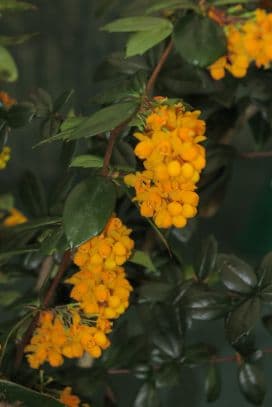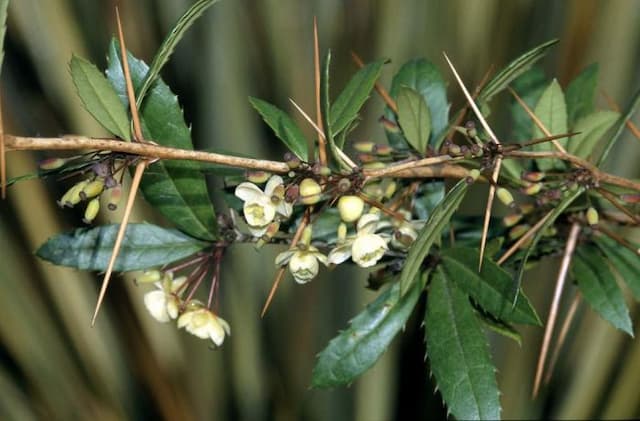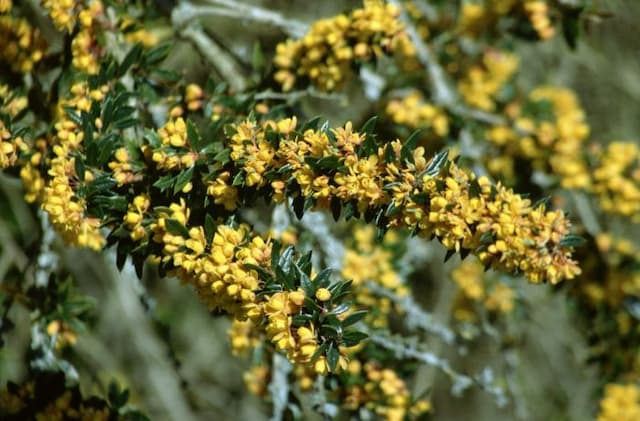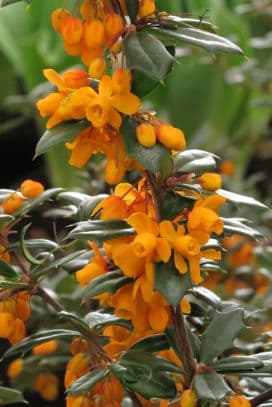Heavenly Bamboo Nandina domestica 'Gulf Stream'

ABOUT
The Gulf Stream Nandina, often referred to as Heavenly Bamboo due to its resemblance to bamboo in its foliage structure, is a compact, evergreen shrub that boasts a multi-stemmed, upright, and bushy form. Its lacy, fine-textured foliage shifts through various colors with the seasons. The new leaves emerge in spring with bright shades of pinkish-red, then transform into a beautiful blue-green as they mature. In the cooler fall months, the leaves take on rich hues of reddish-orange, offering a vibrant display of fall color. Clusters of small, star-shaped, white flowers appear in late spring to early summer, adding a soft, airy texture to the plant's appearance. The Gulf Stream Nandina's flowers give way to bright red berries in late summer and fall, which contrast strikingly with the ever-changing foliage. These berries can last through the winter, providing a pop of color in an otherwise dormant landscape. The Gulf Stream Nandina's graceful form and changing color palette, combined with its tolerance for a range of conditions, make it a popular choice for gardens looking for year-round interest without growing too large. Its feathery foliage and bright berries also make it a visually striking addition to mixed borders, foundation plantings, and as a focal point in decorative pots or containers.
About this plant
 Names
NamesFamily
Berberidaceae
Synonyms
Heavenly Bamboo, Sacred Bamboo, Nandina
Common names
Nandina domestica 'Gulf Stream'.
 Toxicity
ToxicityTo humans
Heavenly bamboo contains compounds that can be toxic to humans. The berries are especially toxic when ingested in large quantities. Symptoms of poisoning may include nausea, vomiting, abdominal pain, diarrhea, and difficulty breathing. In severe cases, it can result in respiratory failure and death, particularly for young children who might be tempted by the berries.
To pets
Heavenly bamboo is toxic to pets, particularly cats, dogs, and grazing animals. The berries of the plant contain cyanogenic glycosides, which can release cyanide when digested. Symptoms of poisoning in pets include drooling, weakness, difficulty breathing, incoordination, dilated pupils, and seizures. Consuming a large quantity of the berries can be fatal, hence immediate veterinary attention is required if a pet is suspected of ingesting any part of the plant.
 Characteristics
CharacteristicsLife cycle
Perennials
Foliage type
Evergreen
Color of leaves
Mixed
Height
3-4 feet [0.91-1.22 meters]
Spread
2-3 feet [0.61-0.91 meters]
Plant type
Shrub
Hardiness zones
6-9
Native area
East Asia
Benefits
 General Benefits
General Benefits- Low Maintenance: Nandina domestica 'Gulf Stream', or Heavenly Bamboo, is easy to care for and requires minimal upkeep once established.
- Year-Round Interest: The plant offers a range of colors throughout the seasons, from new red growth in the spring to rich green in summer and vibrant reds and oranges in the fall and winter.
- Drought Tolerant: Once established, Heavenly Bamboo is quite drought-tolerant, making it suitable for xeriscaping and in regions with limited rainfall.
- Pest and Disease Resistant: It is known for being resistant to many common pests and diseases, reducing the need for chemical treatments.
- Compact Growth Habit: 'Gulf Stream' has a naturally compact and well-branched growth habit, making it suitable for small gardens or as a container specimen.
- Versatile Landscaping Plant: This cultivar can be used for a variety of landscaping purposes, such as hedging, foundation planting, or as a focal point in a garden bed.
- Attracts Wildlife: The plant produces clusters of berries that are attractive to birds, providing food for local wildlife.
- Tolerates Variety of Soils: Heavenly Bamboo can adapt to a wide range of soil types, though it prefers well-draining soils.
- Urban Tolerant: The plant is also known for its ability to tolerate urban conditions, such as pollution and limited space.
- Non-Invasive: Unlike some Nandina varieties, 'Gulf Stream' is considered non-invasive, making it a responsible choice for planting in diverse environments.
 Medical Properties
Medical PropertiesThis plant is not used for medical purposes.
 Air-purifying Qualities
Air-purifying QualitiesThis plant is not specifically known for air purifying qualities.
 Other Uses
Other Uses- Photography Prop: The vibrant foliage and berries of the Gulf Stream provide a beautiful, natural backdrop or accent for outdoor photography sessions.
- Winter Garden Focal Point: As Gulf Stream retains its leaves and often its bright berries in winter, it can provide a much-needed splash of color in dormant winter gardens.
- Symbolic Use in Festivals: Due to its red berries, it can be used as a symbol of prosperity and good fortune during festivals or cultural events, particularly in East Asian inspired garden displays.
- Privacy Screening: When planted in a series or row, Gulf Streams can form a semi-evergreen privacy screen for yards or patios, maintaining some foliage year-round.
- Holiday Decor: The branches and berries can be cut and used in holiday wreaths or festive arrangements as a natural decorative element.
- Culinary Garnish: Though the plant and berries are toxic if ingested in large quantities, small amounts can be used as a non-edible, decorative garnish for upscale culinary presentations.
- Craft Material: The wood from pruned Gulf Stream branches can be used in crafting, for making small wooden objects or as part of decorative items.
- Aquascaping: Driftwood-like branches from the Gulf Stream can be used in aquariums for aquascaping, providing a natural look and structure for fish to explore.
- Teaching Tool: Gulf Stream can be used in educational settings to teach about plant growth, berry production, and the importance of plant toxicity awareness.
- Dye Production: The berries, while toxic, could theoretically be used to produce natural dyes for use in art projects or textiles, taking proper precautions to prevent ingestion.
Interesting Facts
 Feng Shui
Feng ShuiThe Heavenly Bamboo is not used in Feng Shui practice.
 Zodiac Sign Compitability
Zodiac Sign CompitabilityThe Heavenly Bamboo is not used in astrology practice.
 Plant Symbolism
Plant Symbolism- Resilience: Nandina domestica 'Gulf Stream', commonly known as Heavenly Bamboo, often symbolizes resilience due to its ability to withstand various conditions and bounce back from adversity.
- Change: The varying colors of the foliage, which can change with the seasons, represent the idea of life's constant changes and transitions.
- Longevity: Since Heavenly Bamboo is an evergreen, it's associated with long life and immortality, reflecting a perennial presence through time.
- Protection: In traditional Eastern cultures, Heavenly Bamboo is believed to ward off evil spirits, thus symbolizing protection and safety.
- Good Fortune: Because of its association with longevity and protection, Heavenly Bamboo is often believed to bring good luck and prosperity to the household.
 Water
WaterHeavenly Bamboo, or Nandina domestica 'Gulf Stream', should be watered deeply, ensuring moisture reaches the root zone. During the first growing season, water the plant once or twice a week to maintain a moist soil environment. Once established, water needs decrease, and the plant will require water only when the top inch of soil feels dry to the touch. In terms of volume, a general rule is to provide about one to two gallons of water every week during the first growing season, adjusting as necessary for rainfall. In subsequent years, watering can be reduced, with supplemental watering provided during extended periods of drought.
 Light
LightHeavenly Bamboo thrives in a location that offers full sun to partial shade. The plant performs best with at least four to six hours of direct sunlight per day. A spot that receives morning sunlight and afternoon shade, or dappled sunlight throughout the day, is ideal to prevent leaf scorch in areas with very intense sun.
 Temperature
TemperatureHeavenly Bamboo is hardy and adaptable, doing well in a wide range of temperatures. It can tolerate minimum temperatures down to around 0 degrees Fahrenheit, while its maximum tolerance is generally around 90 to 100 degrees Fahrenheit. For optimal growth, maintaining temperatures between 60 and 80 degrees Fahrenheit is ideal.
 Pruning
PruningPruning Heavenly Bamboo is often unnecessary, but if needed, it should be done to remove any dead or damaged branches, to shape the plant, or to maintain size. The best time to prune is in late winter or early spring before new growth starts. Pruning can be performed annually, but many gardeners will only prune every few years as this plant is low-maintenance in terms of trimming.
 Cleaning
CleaningAs needed
 Soil
SoilHeavenly Bamboo 'Gulf Stream' thrives in a soil mix with good drainage, composed of loamy or sandy soil enriched with organic matter. The ideal soil pH for this plant ranges from slightly acidic to neutral, around 5.5 to 6.5.
 Repotting
RepottingHeavenly Bamboo 'Gulf Stream' does not require frequent repotting; it should be repotted every 3-4 years or when the roots have filled the pot.
 Humidity & Misting
Humidity & MistingHeavenly Bamboo 'Gulf Stream' prefers moderate humidity but is adaptable and can tolerate the average indoor humidity levels found in most homes.
 Suitable locations
Suitable locationsIndoor
Place Heavenly Bamboo in bright, indirect light and away from drafts.
Outdoor
Plant in sun to part shade, shelter from strong winds.
Hardiness zone
6-9 USDA
 Life cycle
Life cycleNandina domestica 'Gulf Stream', commonly known as Gulf Stream Heavenly Bamboo, starts its life as a seed, which germinates during the warm season when conditions are optimal, requiring well-draining soil and some moisture. After sprouting, the seedling grows into a small shrub, developing its signature compound leaves and woody stems over time. As it matures, the plant reaches its full size of up to 3 feet tall and wide, producing clusters of small white flowers typically in spring. Following flowering, it may produce bright red berries if pollination occurs, which then serve as a food source for birds and a means of seed dispersal. Throughout its life, Gulf Stream Heavenly Bamboo undergoes seasonal changes with leaves that may turn reddish in the fall and winter. The plant has a perennial life cycle, living and producing flowers for many years, and may also spread through suckering, creating clonal offshoots from the main plant.
 Propogation
PropogationPropogation time
Spring-Early Summer
Propogation: The most popular method for propagating Nandina domestica 'Gulf Stream', commonly known as Heavenly Bamboo, is through semi-hardwood cuttings. The best time for this is during late summer. Cuttings should be taken from healthy semi-hardwood stems, usually 4 to 6 inches long (approximately 10 to 15 centimeters), and stripped of their lower leaves. The cut end is then dipped in rooting hormone to encourage root development and placed in a well-draining soil mixture. It's important to keep the cuttings moist and in a warm environment with indirect sunlight until they have rooted, which can take several weeks. Following this method allows for the cloning of the parent plant, maintaining its desirable characteristics.







![Japanese barberry [Bonanza Gold]](/_next/image?url=https%3A%2F%2Fplants-admin.emdemapps.com%2Fimages%2Fplants%2F%2Fimages%2F604b5385e413f.png&w=640&q=75)

